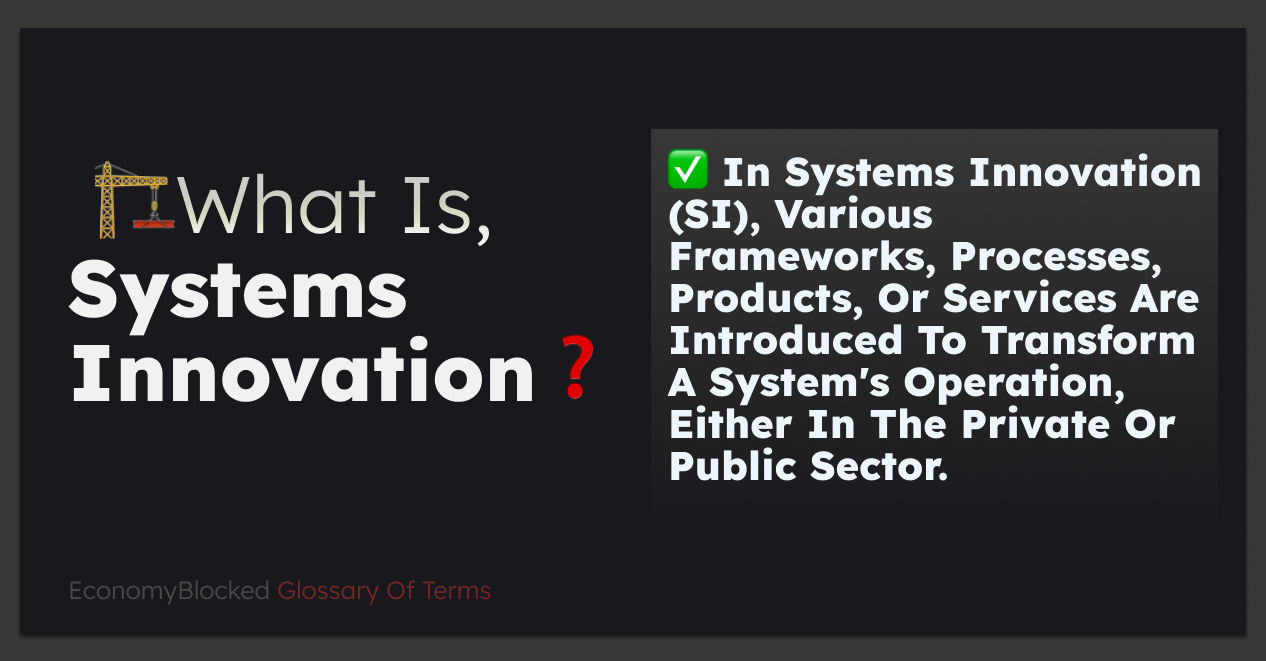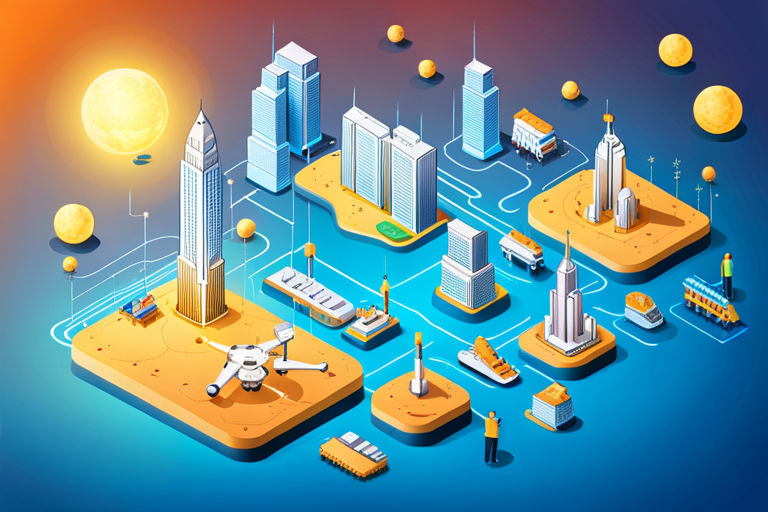📖 Glossary of terms

✅ In short, systems innovation helps identify and resolve the underlying causes of problems within a system by developing novel approaches to solving them. It also considers the impact or value of each node and person within the system itself by analyzing the entire value chain, both physical and digital. Through SI, solutions transcend the digital/physical world, using a homogenized approach that views them as one and the same.
🌌 SI, short for systems innovation emphasizes a holistic understanding of systems, stakeholder engagement, and iterative learning processes to create long-lasting, sustainable change across societies and governments or ORGs/teams of all sizes; Reframe traditional problem-solving methods by considering interconnections and interactions within a system, rather than focusing on individual components or symptoms in isolation.
🕰 Analog to digital process implementation
Over millennia, man has used processes to remove complexity or increase efficiency, and in the post-war era, the world of designing complex systems has been in direct response to the digital age, from Agile, scrum, and control theory methodologies to design thinking. A number of the methods were developed in response to the ineffectiveness of existing methods of solving problems or the absence of consideration for the delineating pain points of those developing digital systems in an era where analog processes and frameworks were transitioning to digital processes.
🚇 An example use case for Systems Innovation
The public transportation system is a good example of how systems innovation can be applied. When designing a new train line and stations, systems innovators will consider a new train line’s value more granularly. They will consider as many edge and corner cases as possible from a value-based perspective, rather than their aggregate value or independent edge/corner cases. In system innovation, users (people) are viewed as nodes within a value chain in the same way infrastructure is considered in the transportation-focused example. We can port this same example to any industry to frame the problem space systems innovators are working to solve.
Artificial intelligence (AI) and machine learning (ML), complex robotics, climate change, political instability, war, decentralized ledger technology (DLT), autonomous vehicles and transportation, financial systems, and the list goes on. Systems innovation was born out of the challenges of the modern era, where the systems and issues we’re currently facing are more ethereal and complex than ever before.

🌍 Framing the value proposition for systems innovation
As we think about the current state of many of the systems we interact with on a daily basis, both privately owned and publicly run, we can capture the true value proposition of Systems Innovation. In this example, we will focus on the US. A close examination of each of our social and industrial systems, including healthcare, education, public transportation, financial services, government, family, etc., indicates that we are operating on a system that was largely defined in the early 19th century, and some of the core issues can be traced back to the 18th century, and the founding of the United States.
A key difference between each of these systems is that they have not innovated to meet the demands of a changing society. Thus, many of these challenges will require new tools, frameworks, processes, services, and systems of thinking to work through.
🎓 How to learn more about Systems Innovation
You can learn more about Systems Innovation by checking out the SI Network platform, an online community of systems innovators across most career designations and continents– Another excellent reference is the Systems Innovation: Definitions, Examples, and Benefits post by MIT ID Innovation, which can be found here.
👾 More Recent-Posts
-
Bitcoin (BTC) Revolution: Catalyst, History, and Analysis
The main goal of this piece is to gain a deeper understanding of the reasoning behind the creation of Bitcoin, allowing for a more comprehensive perspective on its future
-
Macro & Geopolotics Report: 2023 Business Trends Report
In this post, we discuss macroeconomics, as well as geopolitics as part of the 2023 Business Trends Report 🌍
-
💲NEAR Protocol: Overview and Price Prediction
In this article, we will be conducting an extensive analysis of the 💲NEAR protocol, which is the platform I have the most experience building dApps on, as a Product Manager in web3
-
8 Healthcare Industry Trends and Innovations
In this post, we will be reviewing 8 business trends for the healthcare industry, including each of it's sub-industries, such as MedTech🔬
-
Cardano(ADA) Overview and Price Prediction
As a part of this post, we'll be reviewing what Cardano (ADA) is, its benefits, Tokenomics, a price prediction model, and the future of its fledgling ecosystem 💱
-
Ruby on Rails and The Future Of MVC
Discover the amazing potential of Ruby on Rails! Learn about its history and design philosophy, why it's the perfect choice for web development, and how to get started with the framework ♦️
-
Artificial Intelligence: Business Trends Report
Large language and generative models are reaching a point of emotional realness that they can no longer be distinguished from humans 🚀
-
2023 Geopolitics Report
A guide to help both businesses and product managers use geopolitics as a strategic advantage in 2023
-
Post-Industrial Digital Banking
Explore the post-industrial era of digital banking. Deployment-based market research, post-industrial hypothesis validation,opportunities,and more 📲
-
How 👾 (AI) Will Transform Product Management
In this post, we will unpack how (AI) will transform aspects of product management, as well as it's impact across cross-functinoal teams 🎖️
-
2023 Transportation Industry Trends 🚊
In this post, we will be covering 2023 Transportation Industry Trends, including market research, business strategy, and more... 🚉
-
Energy Sector Forecast 2023 ⚡
The 2023 Business Trends Report covers sector-based projections, major innovations, market dynamics, opportunities, and technologies by sector or industry - this post covers both traditional and renewable energy markets 📈
-
To-Blog Or Not-To Blog❓ | 2023 Blog Launch Helper |
This post is designed to help you or your team launch and optimize a successful blog by examining why businesses blog, providing a blog business plan guide, exploring SEO and analytics tools, and an overview of blogging platforms and frameworks
-
Make the web fast again | What is a CDN❓| How do CDNs work❓
In this post, we review what a CDN is, how they work, the business of cdns, as well as some of the best options to consider when choosing a cdn
-
We're In Way Over Our Heads | Going Headless (CMS)
Content is king! In this post we review Headless-CMS, content management systems; How they work, an overview of JAMstack, some of the best options, etc, will be discuessed
-
Building Static Websites In An Un-Static-World (SSGs)
In this post we'll be reviewing (SSGs) static site generators, reviewing the tech as a means of providing value to your next project or business during times of uncertainty– The advantages, how they work, and evaluating frameworks, including Jekyll, Hugo, and Gatsby. JS, etc 🛠
-
How (AI) is changing the way we work
In this post, we'll explore two use cases for (AI) ⚔️ (AI) Writing and Text-To-Image (Generative-AI) – How they work, as well as their current and future, use cases for the workplace, as well as available tools and services
-
Industrial Revolutions
Part-1 (1-2 IR) This is the first post of the Industrial Revolution series, covering the 1st and 2nd Industrial Revolutions, major tech innovations and advancements during each period
-
Industrial Revolutions
Part-2 (3-4 IR) This is the second and final post of the Industrial Revolutions series, covering the 3rd and 4th Industrial Revolutions. Focusing on the tech and innovations during this period
-
Tokenomics
Ledgers and Accounting represent two foundational aspects of tokenomics and token-engineering, this is the first of many post where I will be covering tokenomics, focusing on presenting my research and aspects of system design
-
Fintech Deep-dive
How the tech industry is changing finance: This post outlines the history of financial technology (FinTech) and major innovations, as well as companies at the forefront of this sector
-
Web 3 Systemic Issues Report
In this post I review some of the most systemic-issues that I have identifed after contributing to a few web3 startups in varying levels of involvement – please take what is stated as speculative conjecture, nothing more 🙏